Arkansas Novaculite also known as Whetstone and other rocks found in nature!
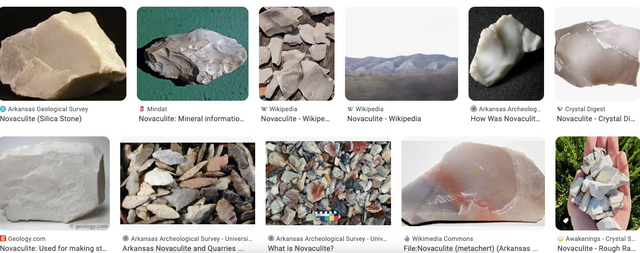
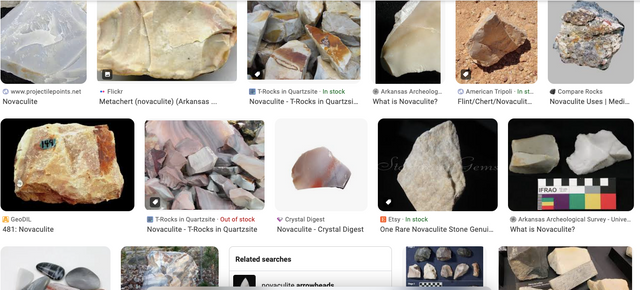
As per Dan's Whetstone Novaculite 101
The History of Novaculite:
Novaculite is a sedimentary rock composed of microcrystalline quartz, it is also recognized as a re-crystallized variety of chert. It is a high-purity silica, composed of more than 99 percent pure silica. The name is applied mainly to formations in Arkansas, Oklahoma, and Texas and is derived from the Latin word novacula, meaning razor stone. Novaculite is the rarest and finest abrasive stone in existence.
Found in depths of 250 to 900 feet, novaculite was formed during the Mississippian and Devonian ages (about 350 million years ago). The stone naturally resists erosion and forms prominent ridges in the Ouachita Mountain range. The quantity of available novaculite is immense. Whetstone quality novaculite is found predominantly in Garland and surrounding counties in the massive lower division formations. However, individual quarries exist from Little Rock in Pulaski County westward towards Hatton in Polk County. The amount of novaculite that exists in these formations will allow for the continued production of sharpening and abrasive products for as long as the demand and profitability is there to sustain the industry.
Mining records indicate that settlers in this region began mining in the early 1800’s near Magnet Cove in Hot Springs County. novaculite mining began in Arkansas intermittently from 1885 to 1905, and since that era mining has remained constant. Before the Europeans came to know Arkansas whetstones for their unique and superior sharpening and abrasive qualities, the Native Americans of the region gathered and quarried for novaculite to make weapons and tools like arrowheads, spearheads, knives and axes. This process is known as Flint Knapping. There is evidence that trading between the tribes resulted in the distribution and use of novaculite hundreds and maybe thousands of miles from the source.
Red is Hot and Blue is Cold, Right?
What color is your Arkansas Novaculite Whetstone? Black? Blue-black? Charcoal Gray? White? Multi-color? Brown? Grey? Pink? Red? Sometime during the history of Arkansas whetstone production someone came up with what, at the time, seemed like a good idea. Arkansas stones come in a variety of colors, so why not associate a stone’s color with its grade (how hard or soft it is)? It wasn’t a bad idea in the beginning. Now, however we know that many of the same colors exist in more than one grade of stone so it gets confusing for the consumer and very limiting for the manufacturer.
Arkansas whetstones can be found with any of the following colors: pink, gray, rust red, black, blue-black, white, brown, purplish red. At times, one will find a combination of some of these colors in the same stone. Color however, does not distinguish the difference in the hardness of the stone. With a trained eye color can be used as one factor when distinguishing between grades of stone. But, only when used in conjunction with other indicators such as opacity, texture, luster, weight and mining formation. Using only the differences in color during the grading process is not a reliable indicator of stone grade.
https://danswhetstone.com/information/novaculite-101/
Other interests in Arkansas
Found at American Mineralogist
Volume 14 written in 1929
For over a century Magnet Cove, Arkansas, has been visited by mineralogists and geologists who have come to seek out its treasures. Magnet Cove is located on Arkansas Highway No. 6, twelve miles east of Hot Springs. As the name implies, this is a locality in which there is a large amount of magnetic iron ore.
From the external appearance and general features of the cove many have believed this to be an ancient volcanic crater. More recently, however, the general consensus of opinion is that it is formed of intrusive igneous rock. The surrounding area is of the Tertiary age.
There are a number of separate areas in this small cove which abound in beautiful specimens. Recently the Highway Department made a cut through a small hill and exposed some beautiful deposits. This cut is on the highway just west of the Cove Creek Bridge. Here was exposed some of the most beautiful eudyalite crystals, also aegirite, acmite, calcite, vesuvianite, thomsonite, biotite, dysanalyte and wavellite.
Figure 1 gives an idea of how this cut appears. The bulk of the rock exposed is calcite. In between the ledges of calcite is the igneous rock which contains the beautiful crystals. Vesuvianite crystals may be found in the loose soil. By being careful not to roll any boulders on the highway one may do considerable digging here, which will be most profitable. It might be well to state that many pass this up as containing no interesting specimens, as it is very unpromising on a casual examination.
Another choice collecting spot is a small knoll about 250 yards south west of the Cove Creek Bridge. Here is found dysanalyte, magnetite, pyrite, limonite pseudomorphous after pyrite and the rare rutile 8-lings. It is possible that at one time these crystals were embedded in the calcite, but were liberated by weathering and decomposition. These crystals are now found loose in the soil.
Going east on the highway one will pass an old church on the left side of the road about ½ mile from Cove Creek Bridge. In front of this church there is a small creek, which is well worth examining. In this creek bed may be found small crystals of schorlomite, apatite, biotite, quartz and feldspar. These specimens are not numerous and are rather small, but are very handsome.
The highway cuts through several deposits of vermiculite, between Cove Creek Bridge and the eastern rim of the cove. Just which one of the vermiculites this is, I can not say. In the Proceedings of the Academy Natural Sciences of Philadelphia, 1877, page 277, Dr. G. A. Koenig calls this protovermiculite and gives an analysis comparing it with biotite from Mt. Vesuvius. Along with these deposits, in many instances, is a small amount of schorlomite but poorly crystallized.
One of the most cherished minerals found at Magnet Cove is brookite which is also referred to as arkansite. This mineral occurs in beautiful crystals on Quartz in a small area extending north and south from the Magnet postoffice, which is on the eastern rim of the crater.
From Magnet Cove the following minerals have been reported: acmite, aegirite, actinolite, augite, ankerite, allophane, apatite, arkansite, biotite, braunite, chrysolite, calcite, dysanalyte, eudyalite, microcline, novaculite, nephelite, (eolite), ochre, monticellite, rutile, smoky quartz, schorlomite, tufa, vesuvianite, protovermiculite, variscite, phlogopite, wavellite, xanthophyllite, orthoclase, sodalite, astrophyllite, illmenite, talc, pyrite, thomsonite, cancrinite, pyroxene, titanite, amphibole, wollastonite, natrolite, plagioclase, brucite, manganopectolite, diopside, melanite, leucite, pseudoleucite, olivine and perofskite.
The entire cove is privately owned by a number of farmers, but the majority are very accommodating and will not object to trespassing unless the crops are needlessly destroyed. There is a good camp ground just to the right of the Highway on the west bank of Cove Creek. Excellent hotel accommodations may be had at Hot Springs.
Any one visiting this locality should also go to Crystal Mountain which is 18 miles west of Hot Springs on Highway No. 6, the same Highway Magnet Cove is located. Here same good specimens of quartz crystals may be secured.
By turning off of Highway No. 6 some distance west of Hot Springs as directed by signboards, one will come to Cedar Glades; continue on beyond this town to a small village about two miles farther. Here take the road to the right and go to Dug Hill, a familiar spot to the natives. At this locality may be secured beautiful green specimens of wavellite and variscite. It is necessary to dig in the old pits, abandoned some 40 years ago and now almost hidden from view, in order to get these specimens.
About 60 miles west of Hot Springs, is Murfreesboro. Here is the famous Arkansas Diamond Mine. This mine is surrounded by a fence but visitors may be admitted. Good samples of green peridotite in which the diamonds are found, may be secured. If this trip to Murfreesboro is taken one will pass Glenwood. At this point a road leads to the right and about 6 miles from here is a large cut where specimens of dendritic manganese dioxide may be found. This is a pass through which Caddo River, the railroad and highway pass before reaching the village of Caddo Gap.
http://www.minsocam.org/msa/collectors_corner/arc/armagnetn.htm
Arkansite specimens
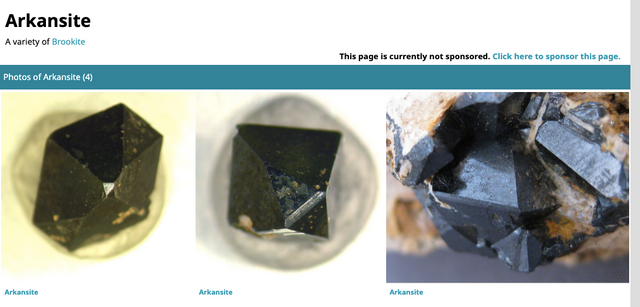
Lodestone
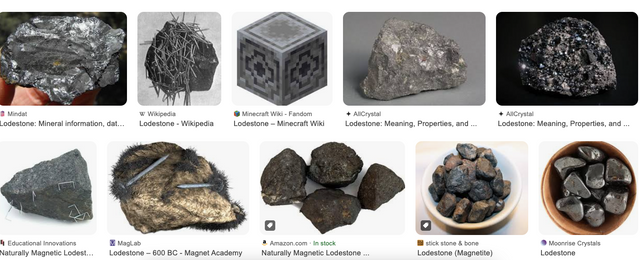
Brookite
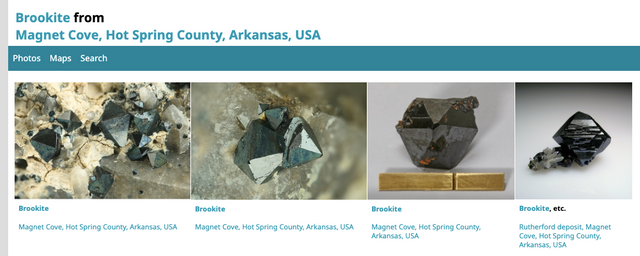
Pyrite mixed with bedrock at Magnet cove
You go across the Iron bridge at Gourd neck Valley Road, it takes a turn to the right and on the right is the creek bed with a lot of pyrite if you dig down 3 to 4 feet down into the bedrock.
Smokey quartz can also be found.
The Creek should qualify as a Protective Easement for public use so hand tool collecting is presumed to be allowed and many have done this as it is public land.
It is known as the Pyrite area of Magnet Cove and location has been known for many years.
No digging on hillside or in ground, but digging is allowed inside the creek.
Pyrite inside rock
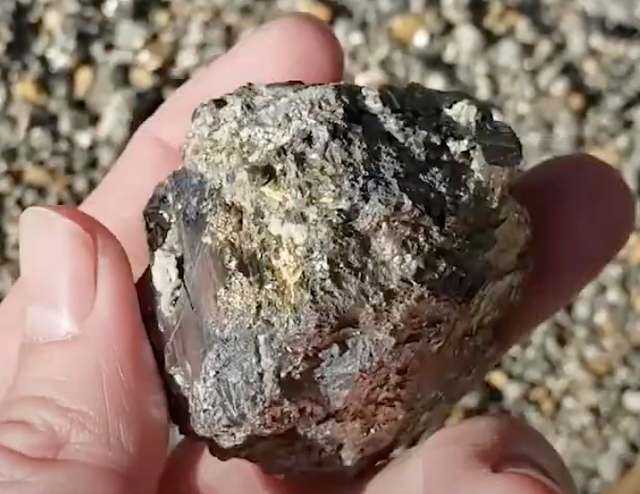
You can also find it in it's cubed form.
Going down Gourd Neck Valley Road after iron bridge take first right
/r/whatsthisrock
Botryoidal Wavellite
(chiefly of minerals) having a shape reminiscent of a cluster of grapes.
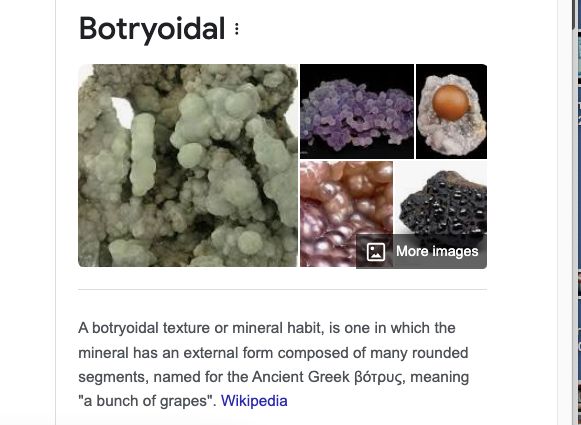
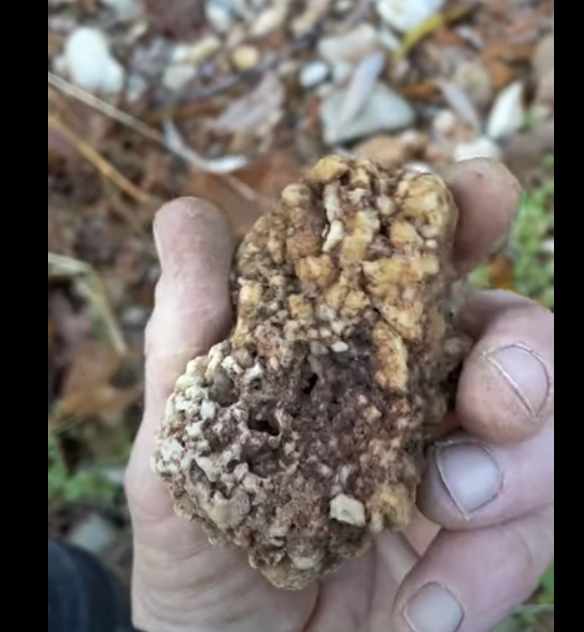
Wavellite Botryoidal
Sometimes just looks like shale at first, but when you get underneath it a bit, can look like this,
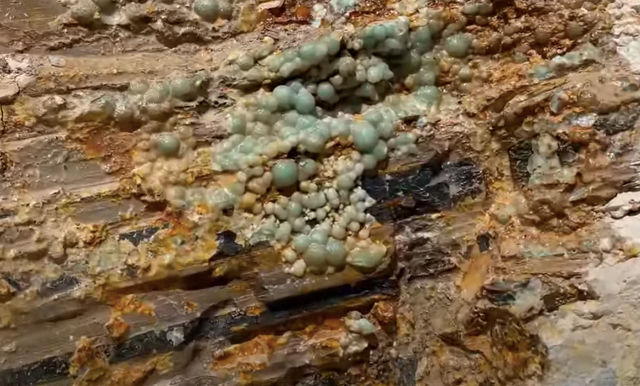
As you can see it can grow in cracks and voids of the matrix
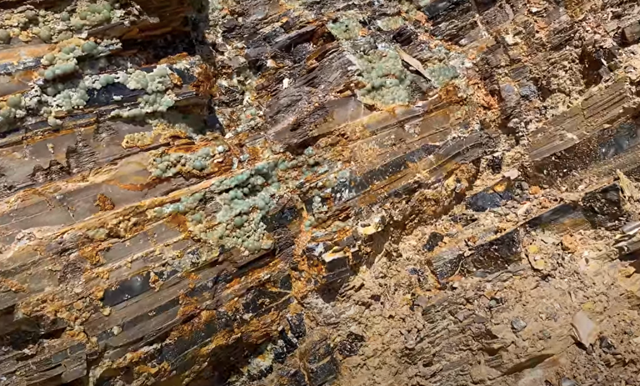
Wavellite is an aluminum basic phosphate metal
It can grow right up on the matrix of novaculite [whetstone]
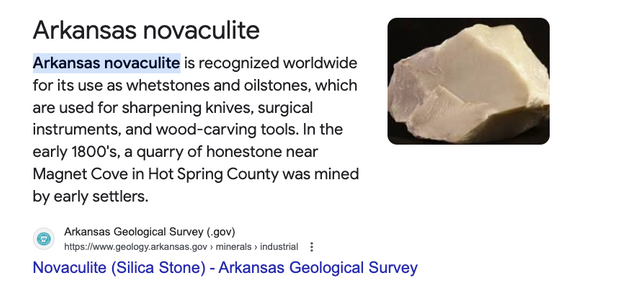
Comes in many different colors, shades and variations.
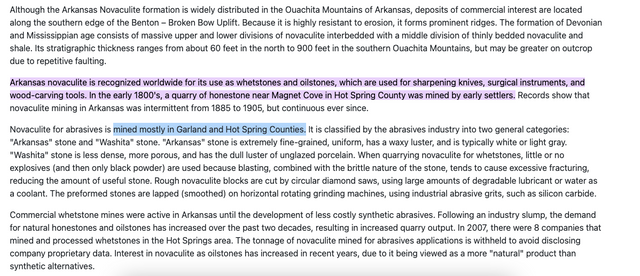
Although the Arkansas Novaculite formation is widely distributed in the Ouachita Mountains of Arkansas, deposits of commercial interest are located along the southern edge of the Benton – Broken Bow Uplift. Because it is highly resistant to erosion, it forms prominent ridges. The formation of Devonian and Mississippian age consists of massive upper and lower divisions of novaculite interbedded with a middle division of thinly bedded novaculite and shale. Its stratigraphic thickness ranges from about 60 feet in the north to 900 feet in the southern Ouachita Mountains, but may be greater on outcrop due to repetitive faulting.
Arkansas novaculite is recognized worldwide for its use as whetstones and oilstones, which are used for sharpening knives, surgical instruments, and wood-carving tools. In the early 1800's, a quarry of honestone near Magnet Cove in Hot Spring County was mined by early settlers. Records show that novaculite mining in Arkansas was intermittent from 1885 to 1905, but continuous ever since.
Novaculite for abrasives is mined mostly in Garland and Hot Spring Counties. It is classified by the abrasives industry into two general categories: "Arkansas" stone and "Washita" stone. "Arkansas" stone is extremely fine-grained, uniform, has a waxy luster, and is typically white or light gray. "Washita" stone is less dense, more porous, and has the dull luster of unglazed porcelain. When quarrying novaculite for whetstones, little or no explosives (and then only black powder) are used because blasting, combined with the brittle nature of the stone, tends to cause excessive fracturing, reducing the amount of useful stone. Rough novaculite blocks are cut by circular diamond saws, using large amounts of degradable lubricant or water as a coolant. The preformed stones are lapped (smoothed) on horizontal rotating grinding machines, using industrial abrasive grits, such as silicon carbide.
Commercial whetstone mines were active in Arkansas until the development of less costly synthetic abrasives. Following an industry slump, the demand for natural honestones and oilstones has increased over the past two decades, resulting in increased quarry output. In 2007, there were 8 companies that mined and processed whetstones in the Hot Springs area. The tonnage of novaculite mined for abrasives applications is withheld to avoid disclosing company proprietary data. Interest in novaculite as oilstones has increased in recent years, due to it being viewed as a more "natural" product than synthetic alternatives.
Other uses of novaculite have included concrete aggregate, road construction material, railroad ballast, riprap, high-silica refractories, and for the recovery of silicon metal. The massive novaculite of the Upper and Lower Divisions of the Arkansas Novaculite is a source of high-purity silica (>99 percent). Individual quarries for novaculite extend from Little Rock in Pulaski County westward to Hatton in Polk County.
There is an extensive, uncalculated, resource of massive novaculite in the Ouachita Mountains. However, top-quality whetstone-grade material appears to be restricted to Garland and Hot Spring Counties. The available tonnage is quite variable from one deposit to another. The market for natural whetstones and oilstones should continue to increase, but competition by other natural and manufactured abrasives may prevent rapid expansion. In 2005, Arkansas ranked 1st in the nation in silica stone (abrasives) production.
Shows a radial spray like a starburst when broken as can be seen below,
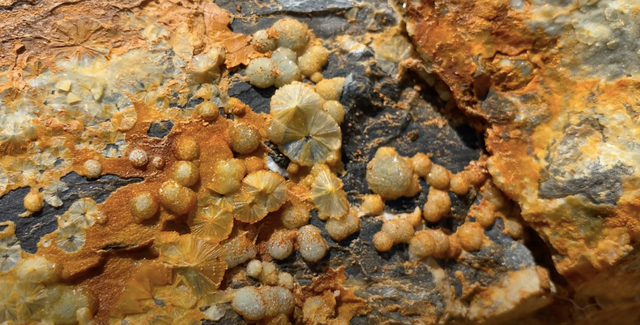
When searching for old mines, you are after free mill gold where there are no sulfides or other elements that would need to be milled out.

https://www.goldprospectors.org/Forum/aft/1516
Look for old milling stations where you can sweep the crevices and look for areas where they were dumping their tailings.
The color of the tailings will indicate the type of ore you should be looking for.
Old timers would use Mercury because gold when it is really clean will stick to the mercury.
Gold and mercury have an affinity for each other.

When they do stick together, they make this cottage cheese silver called amalgam
Other rocks and how to ID
Porphyritic Rhyolite
Rhyolite is a volcanic rock
porphyritic refers to two different size crystals in the rock
In this particular rock there are bigger feldspar crystals
then the smaller reddish ones called brown mass.
Would have erupted from a volcano.
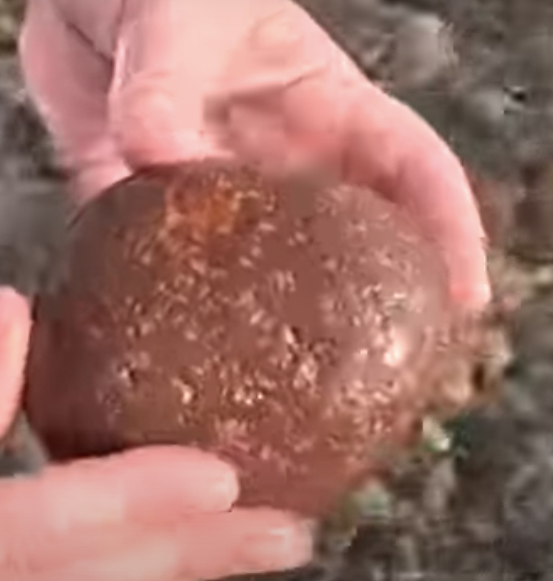
Gneis
Gneisses are metamorphic rock
they form under high heat and pressure
so they get these alternating layers of light and dark mineral in them
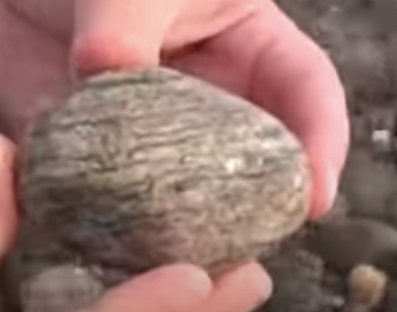
These below are intrusive igneous rock
they formed from magma that cooled and solidified underground
so there are larger crystals in them.
The pink in the one on the left is potassium feldspar.
An igneous rock with a lot of intrusive potassium feldspar,
it is called granite.
The black and white has more plagioclase feldspar and
contains no potassium feldspar.
It has less quartz in it that the potassium feldspar
The black and white is called a diorite.
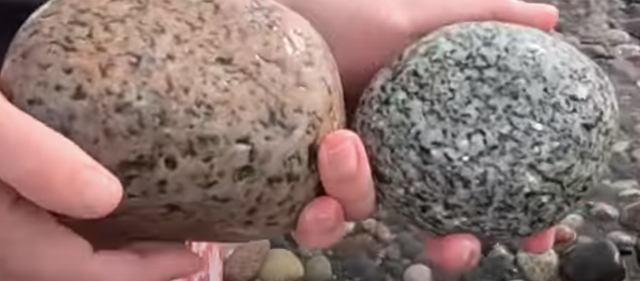
There are a lot of different names for igneous rocks based on the mineral composition.
When people do not know the exact mineral composition, but it has this size and texture,
it is called a granitoid.

Chert
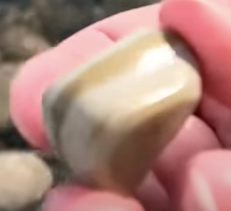

hard, fine-grained sedimentary rock composed of microcrystalline or cryptocrystalline quartz, the mineral form of silicon dioxide.
Unakite
Pink potassium feldspar and epidote
after this rock forms you have fluids going through it
which alters it known as epidotization
and replaces other minerals and puts the epidote in place
which gives the beautiful pink and green rock.
Unakite is a metamorphic rock that's made up of pink orthoclase feldspar, green epidote, and colorless quartz.
Unakite has mottled patterns of green epidote, white to gray quartz, and pink feldspar, occasionally with black veining. It's green with pink/salmon/terra cotta blotches and white speckles.
This one is often called an agate,
but is from Lake Superior and more of chalcedony.
Chalcedony is known to encompass chert, agate, jasper, onyx which all fit under
the term chalcedony.
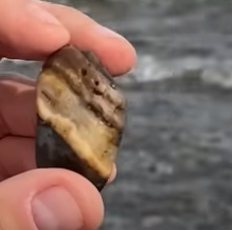
Chalcedony is a type of quartz with a waxy luster that can be transparent or translucent. It's made up of fine layers of quartz crystals and is usually white, pale blue, gray, brown, or black. Chalcedony can also be found in buff, light tan, or other colors.
Another kind of igneous rocks with
big feldspar crystals
but not a lot of quartz so not a granite,
but still classed as a granitoid.
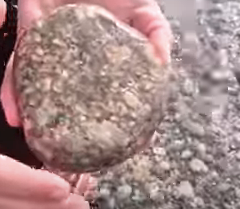
The first two rocks are quartzite which is a
metamorphic sandstone.
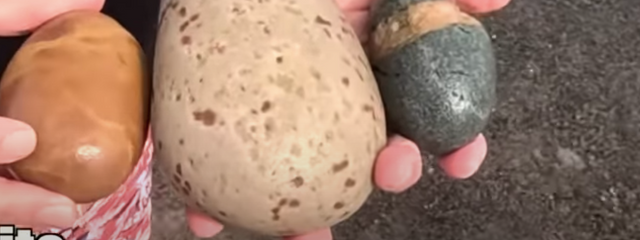

If you look at the first two rocks carefully with a magnifying glass, you will see the tiny quartz grains
which made up the ancient sandstone that got metamorphosed.
They can have different colors and appearances because they had different parent sandstones.
The last rock has a quartz vein cutting through the igneous rock
which is likely basalt
later on hot waters flowed through the basalt and left the quartz behind as the
quartz is a mineral that precipitated out of the water.
Quartz is weakly soluble, so most natural waters contain some dissolved silica that can precipitate as quartz. This can happen when silica-rich waters pass through rocks, filling veins and cavities. For example, quartz can precipitate in geodes at low temperatures.
Quartz can form as an igneous rock when magma cools, or as a sedimentary rock when silica precipitates out of water to form crystals. Quartz crystals usually form near volcanic areas when water is above the boiling point. Quartz is a defining constituent of granite and other felsic igneous rocks, and it's very common in sedimentary rocks such as sandstone and shale.
Quartz is the most abundant mineral in Earth's crust and is resistant to both chemical and physical weathering. When rocks weather away, the residual material usually contains quartz.
Porphyritic Basalt
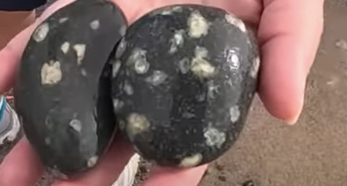
For the larger crystals of quartz would have cooled first and slower
so they got bigger,
then the matrix would have cooled faster making the smaller grains.

Aphanitic Of or relating to an igneous rock in which the crystals are so fine that individual minerals cannot be distinguished with the naked eye.
Aphanitic rocks are extrusive rocks that cooled so quickly that crystal growth was inhibited.
Breccia
They are made of little bits and pieces that have angular edges.
In this one there may be a little jasper that got broken up and
incorporated into this sedimentary rock.
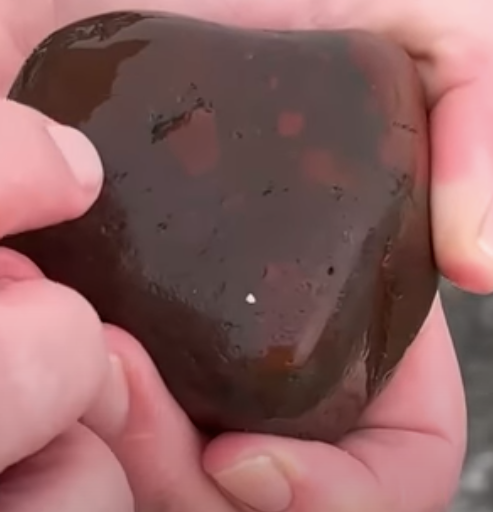

Horn Coral or Rugose Coral
Fossil
Generally shows up where there are beds of limestone or carbonate
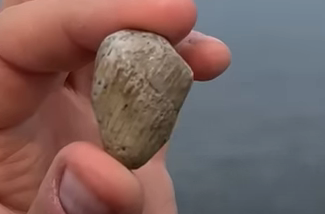
A felsic igneous rock cut by a mafic igneous rock
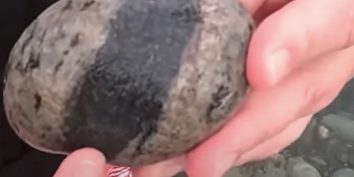
In this rock the mafic is weathering away faster than the felsic part.
This is because mafic minerals which include
olivine, pyroxene and feldspar

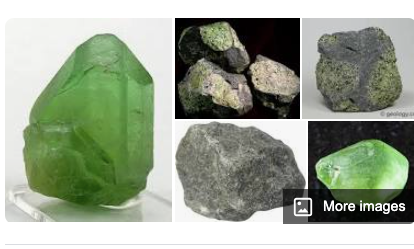


A mafic mineral or rock is a silicate mineral or igneous rock rich in magnesium and iron. Most mafic minerals are dark in color. ..
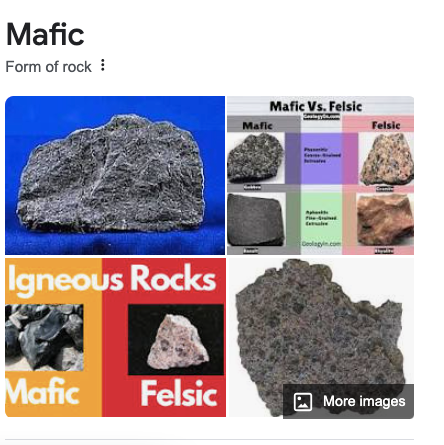
Felsic
Felsic refers to silicate minerals, magma, and rocks which are enriched in the lighter elements such as silicon, oxygen, aluminium, sodium, and potassium.
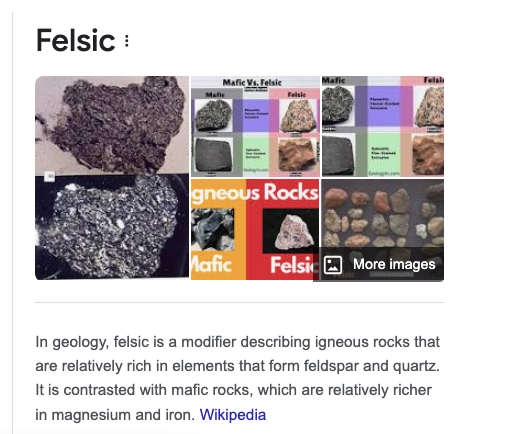
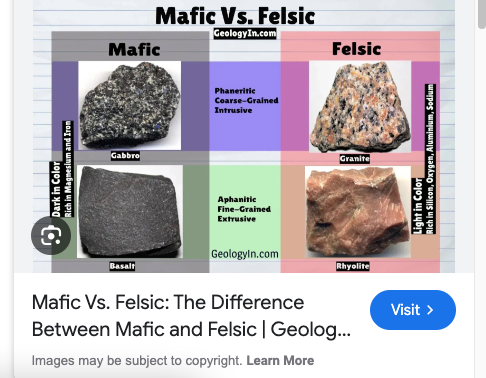
https://www.geologyin.com/2023/09/mafic-vs-felsic-rocks-difference.html
Felsic and mafic rocks are two main types of igneous rocks, which are rocks that are formed from the cooling and solidification of magma or lava.
Felsic rocks are high in silica (SiO2), while mafic rocks are low in silica. This difference in silica content gives the two types of rocks different physical and chemical properties.
Mafic is a term used to describe silicate minerals, magma, and igneous rocks which are rich in magnesium and iron. The term Mafic comes from "magnesium" and "ferric" (iron).
Felsic is a term used to describe silicate minerals, magma, and igneous rocks which are enriched in the lighter elements such as silicon, oxygen, aluminium, sodium, and potassium.
The term "felsic" comes from the words "feldspar" and "silica,".
Quartzite
It's unique because there are dark layers with the quartzite.
You get quartz sand and heavy mineral layers,
it all got metamorphosed showing the different layers.
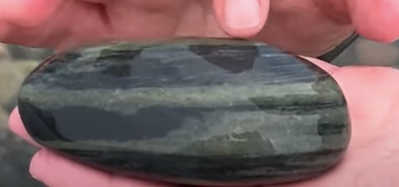
Remember. ..

Mineral quartz
not the metamorphic rock quartzite
When you look at this one with a magnifier you cannot see any of those little quartz sand grains
of an ancient sandstone.
This would have formed with a vein of quartz
and just the mineral being deposited, weathered out and tumbled along the lake.

Basalt with purple
As you turn it around, sometimes you see a glint of gold.
Possibly the blue is labradorite.
When you look inside you might see a glint
It's the way the feldspar grows, you get those twin planes.
The two crystals mirror each other and as the light goes in it kind of
bounces around a bit,
and as you roll it around you're seeing that shiller effect.
Remember. . .
Schiller is also known as play of color, in which the interior of a stone displays flickers of color as it is moved in the light. Opal is especially valued for this trait. There is no actual object inside the stone. This special effect arises from light interference within the microstructure of the mineral.
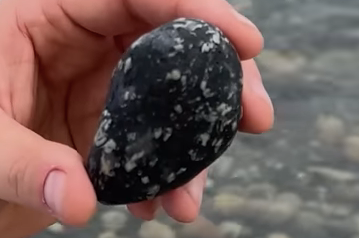
Black Rocks
Basalt [igneous] on left
Omarolluk formation rock on right [sedimentary]
a greywacke, which geologists call a dirty sandstone
when you look closely you see tiny sand grains of lighter color from some quartz and some feldspar
It's called a dirty sandstone because it has a lot of clay and silt, very fine grained material in there,
that surrounds the quartz and feldspar.
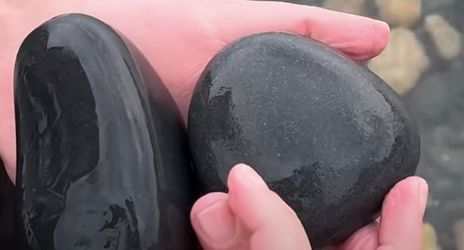
Igneous rock with silvery spots,
which is the mineral muscovite, which is a type of mica.
Muscovite is common in a lot of granites and metamorphic rock.
It breaks down very easily so you don't always see it near water.
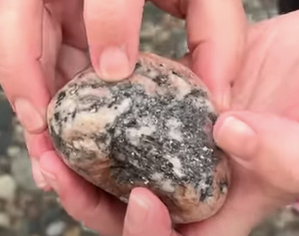
A breccia
because you can see these pieces inside of here
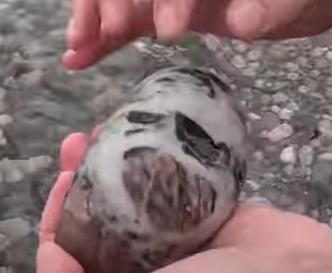

Breccia is a rock composed of large angular broken fragments of minerals or rocks cemented together by a fine-grained matrix. The word has its origins in the Italian language, in which it means "rubble".
Gneiss
Metamorphic rock
you can see shifted pieces or faults
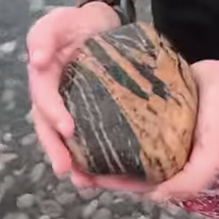

The very distinctive yellow color in this rock is
limonite, which is an iron mineral
it will often stain the outside of rocks.
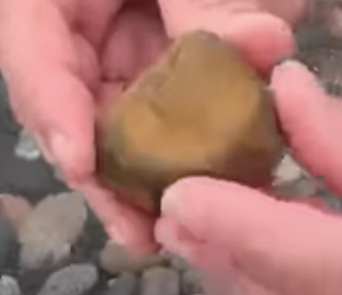
A granite
the black spots inside are the ends of tourmaline crystals
The Tourmaline is also called Schorl, which is the most
common member of the tourmaline group.
The end black pieces are like rounded triangles in this rock.
A very unique rock as the schorles are scattered all over.
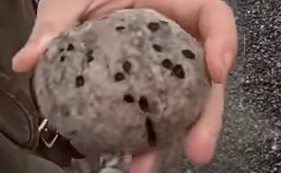
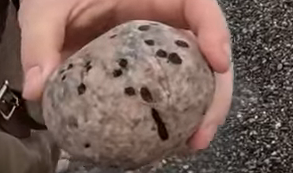

A tiny agate
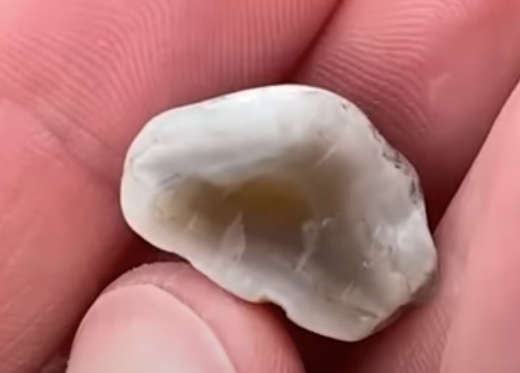
Another agate with the classic banding
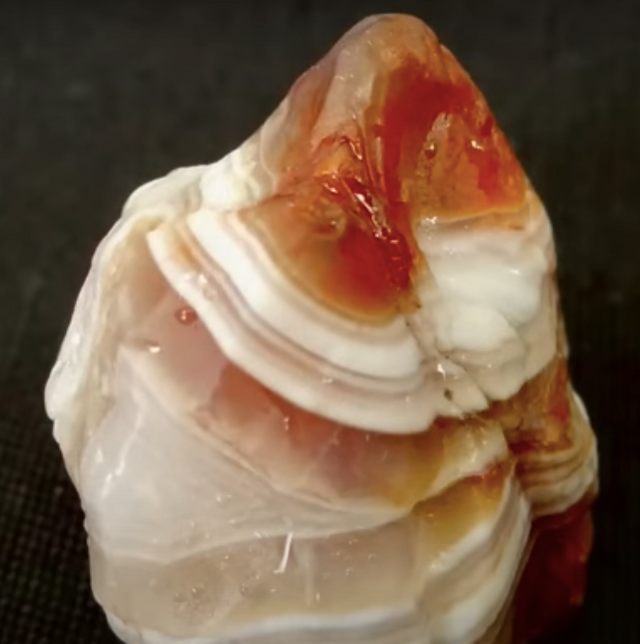
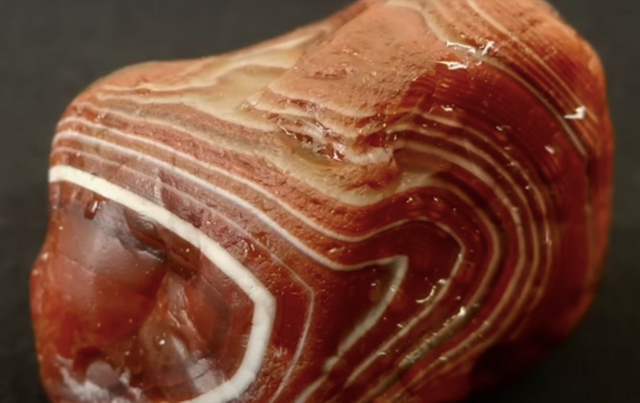
The red ones are due to iron staining.
Agates form in basalt.
This is a structure found in metamorphic rocks called
Boudinage
where you have a think layer that then gets a lot thicker and fatter, then gets thinner again, then fat again going around. the rock.
Comes from a type of sausage called boudin as it reminded people of links of sausage.
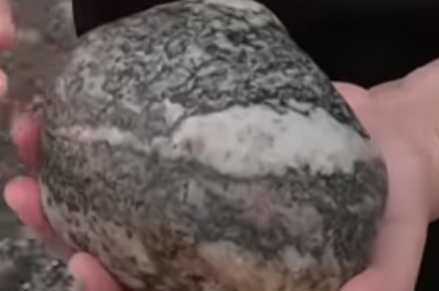
Here is the outside and then the inside of this rock after broken.
It breaks with the conchoidal fracture and sharp edges of microcrystalline quartz,
very tiny crystals of quartz called chalcedony.
This is why it is a bit translucent, has this very pretty color
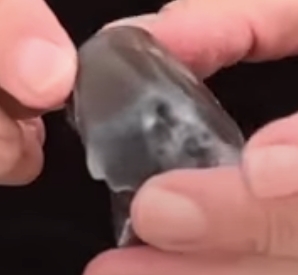
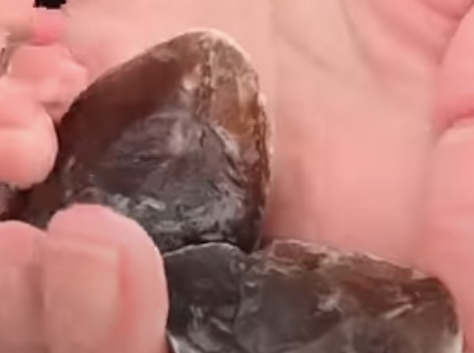
Other types of chalcedony, the top one with jasper
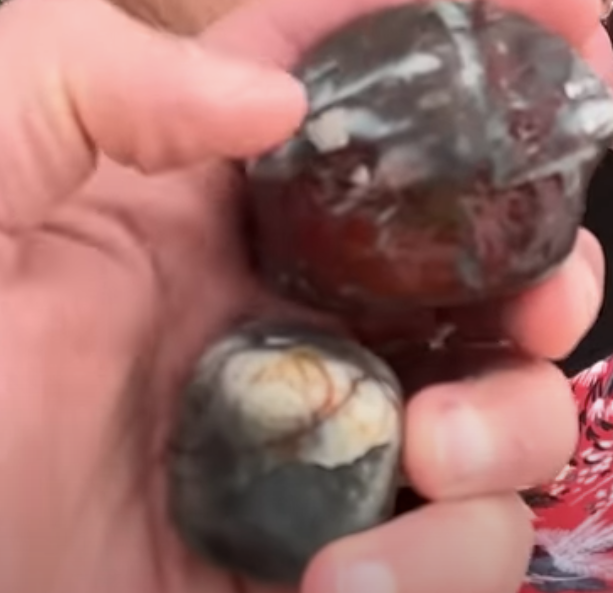
Jacobsville Sandstone
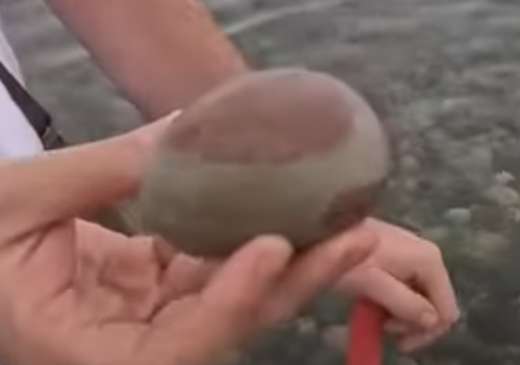
An organism has eaten the red iron part and left the whiter parts which is why you get this two tone effect
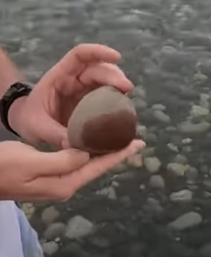
This one is an igneous rock
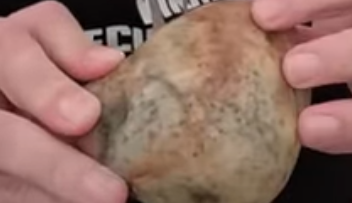
but when you turn it over you see the dark colored metamorphic rock.
It is a xenolith.
Xeno meaning foreign and lith meaning rock, so foreign rock.
When you have igneous intrusions, there is this magma that rises up towards the surface,
sometimes it picks up and engulfs some of the surrounding rock
and that rock doesn't melt, but instead gets stuck in the magma,
so this is what causes the foreign rock or xenolith in the magma.

A Rhyolite with pretty blue crystals.
This one is not Llanite as these blue crystals are not blue quartz
which is very rare.
But in this rhyolite below, the blue crystals are feldspar.
Remember. . .
Quartz breaks in curvy and irregular shapes (conchoidal fracture). Feldspar, however, breaks readily along flat faces, a property called cleavage. As you turn a piece of rock in the light, quartz glitters and feldspar flashes. Other differences: quartz is usually clear and feldspar is usually cloudy.
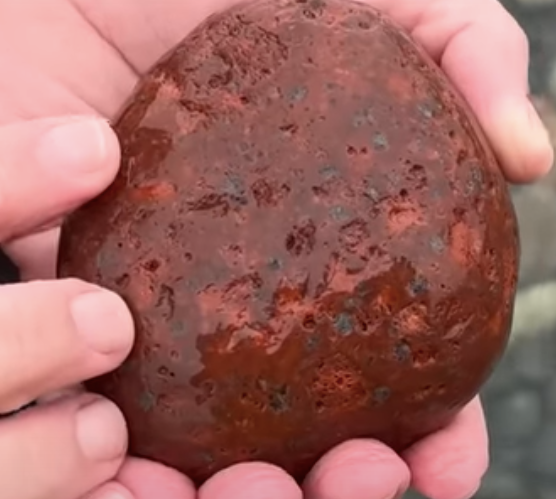
This is a rhyolite with pretty blue crystals from Texas called Llanite
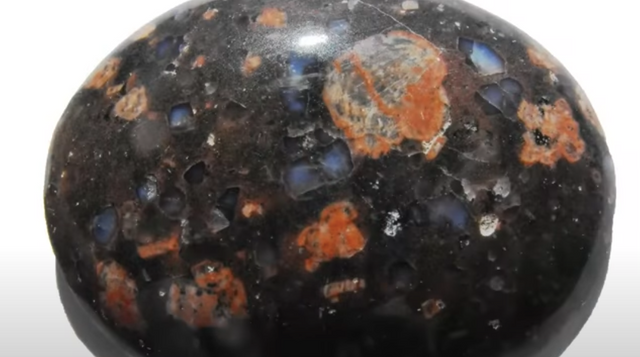
They they look similar, they are different minerals, so they are a different rock type.
This rock is very magnetic and these pieces inside are all surrounded by red.
These could be magnetite crystals or rip up clasts where bits of
banded iron formation got picked up and the edges got oxidized
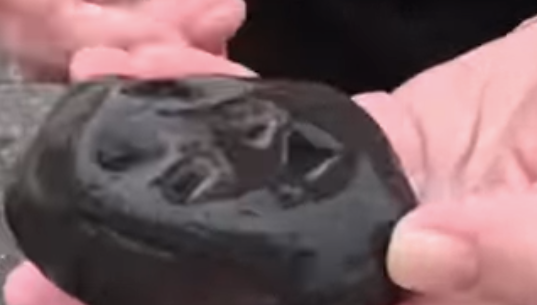
This particular Basalt was the top of a lava flow
as at the top you have the gasses bubbling out.
Towards the top there's less pressure on it, so the bubbles get bigger.
This is why you see smaller ones, then larger ones.
The vesicles or gas bubbles are filled in,
so they are called amygdules and in this rock
they are filled in with quartz.
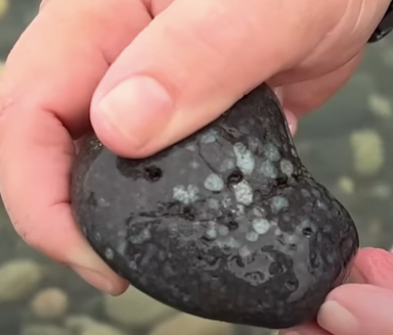
In this rock with a reddish stripe going through,
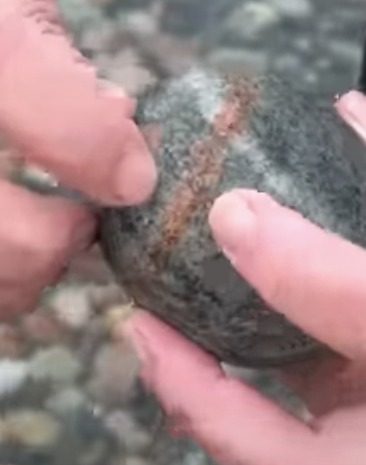
if you look closer you can see that it follows a crack in the rock.
This means hot water was flowing through there and it caused some
hydrothermal alteration.
This means the hot water had some minerals in it and it and with it's hot temperature
it altered the rock as the water flowed through there.
There are all different kinds of hydrothermal alteration that can happen to rocks
which can really change their appearance.
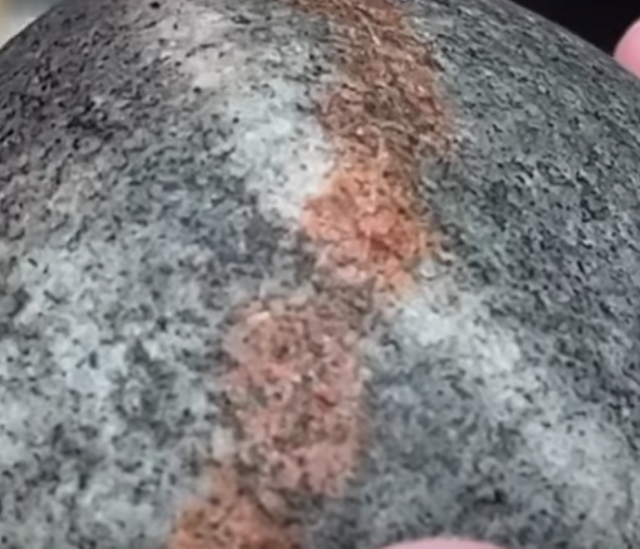
#rockhounding, #novaculite, #whetstone, #mining, #MagnetCove, #HotSprings, #ArkansasRocks